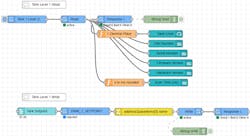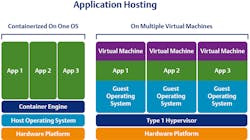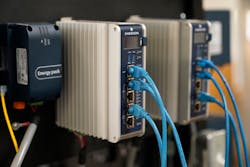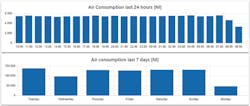Most original equipment manufacturers automate their industrial machinery using proven PLC or dedicated controller technologies for a good reason: They provide the ultimate in reliability. And while the capabilities and ease of use for these traditional platforms have marched forward, they still lag behind many of the features delivered by common consumer-grade technologies.
Today, software developers for the consumer market take advantage of open source code to enable connectivity, databases, visualization and more. Established developers in the industrial operational technology (OT) arena also are finding applications where they would like to use some of these same open source characteristics. Until recently, industrial platforms have not been conducive to allowing these components to snap in so easily.
Machine automation end-users now will find there are options for adding open source projects to enable new features for dedicated industrial control platforms, empowering them to create advanced functionality combined with traditional dependability. This also opens the door for implementers to engage a new generation of developers, designers and engineers already familiar with open source. In short, open source can help OEMs and end users develop high performance solutions.
Why Open Source?
In recent years, a growing contingent of consumers have discovered microcontrollers like the Raspberry Pi and Arduino to create all sorts of automation and information applications. Sometimes these users are known as the “maker” community, and their undertakings are called “homebrew” projects. Some consider this the foundation of the Internet of Things (IoT).
Microcontrollers can be a good development platform in many cases. Implementers are able to mix and match many types of programming languages and constructs to fit the need. Furthermore, much of the coding environment is built upon and draws from open source projects.
For instance, instead of creating a basic operating system or purchasing a proprietary version, Raspberry Pi users benefit from a proven distribution of Linux, developed and improved over decades. Communications are based on standard wired Ethernet and Wi-Fi, using secure firewall-friendly protocols. Users can create code in C++, Python or many other languages, and if they require a database they can select from various options. All these elements are free and supported by large development communities.
While microcontroller platforms like Raspberry Pi are very capable, they are typically not robust and reliable enough for critical industrial applications. However, they do provide a basis for how successful open sourcing can contribute to industrial applications.
Industrial Benefits of Open Source
To gain some insight into how open source can improve industrial automation, it can be helpful to reflect on how and why early hardwired automation progressed to PLCs.
Prior to the rise of commercially viable PLCs in the early 1980s, automation was largely performed with pneumatic components and electrical devices like relays. Large control schemes, such as for machine or elevator logic, required enormous hardwired relay and timer cabinets. These were complicated to design, expensive to build and troublesome to maintain.
PLCs effectively virtualized physical relays into software and made most of the real-time control functions library-based. Instead of reinventing fundamentals each time as specific tangible instances, users could select from standard commands and easily replicate their work. While PLC platforms themselves were proprietary, they enabled open platform concepts of library objects and reusability.
More than Homebrew
Building on these ideas, today’s industrial users are incorporating IT-capable open source technology with their OT-based machine automation systems. To a great extent, this is driven by the desire to incorporate Industrial IoT (IIoT) communication with machine automation, which had typically been mostly standalone.
Open source offers a flexible way to communicate machine data out to remote and cloud-based systems. Other good uses cases are adding advanced operational and analytical computing ability right at a machine. Open source can also enable lightweight dashboard visualization of operational information and key performance indicators (KPIs).
These open source elements are a good fit for industrial machinery applications:
- Ubuntu Linux: A general-purpose operating system for hosting other software
- Cockpit: Lightweight remote Linux server manager
- Docker: Engine for virtualizing and carefully managing application “containers”
- Portainer: Toolset for managing Docker environments
- Node-RED: Graphical programming tool for configuring event-driven data flows
- Influx DB: Time-series database
- Grafana: Analytics and visualization software (dashboards, trends, charts, graphs)
- OPC UA: Common industrial communications protocol specification
- MQTT: Lightweight Ethernet transport
Choosing traditional industrial development environments can be viewed akin to ordering a takeout dinner from a limited menu. Open source, on the other hand, is a little like opening your stocked refrigerator and selecting the ingredients so you can cook up exactly what you want. Takeout is certainly workable, but making one’s own meal can be cheaper, healthier, tastier and more satisfying.
So the question becomes, how does a typical OT controls engineer incorporate these open source concepts, often associated with the IT group, in a simple and reliable way?
Marrying IT with OT
Some enterprising users bridged the IT/OT gap by adding consumer microcontrollers to classic PLC automation. This can work well as a proof of concept but may not deliver the desired reliability for mass deployment.
A better option is emerging, as some suppliers have curated software applications and developed automation platforms directly supporting the use of open source software on industrial-grade systems.
For example, Emerson has assembled an IIoT application enablement platform called PACEdge. Industrial end-users benefit from this type of software stack because the most useful and relevant apps are gathered under a single installation.
Under this model, much of the applications are operated in containers. Just as virtualization allows many independent and self-sufficient operating systems to run on one computing platform, containers enable many individual applications to operate under one operating system.
Containerization makes it easier for users to manage multiple applications and allows each application to run securely, but with regulated options for interacting with other applications. Each application carries all of its necessary dependencies so it can operate in a standalone manner, providing good flexibility.
The operating systems, container environment and applications are arranged so they can be accessed and managed through graphical user interfaces instead of just command lines. This makes it easier for OT personnel to work with this more IT-oriented software.
Support is simplified by offering this open source package with version control, standard configurations, and a factory reset option. To be clear, the configuration is not locked, so the tinkering community can supplement and update the software at will, evolving it over time. However, there is always a clean way to fall back to a known-good configuration.
These features alleviate one of the greatest concerns with implementing open source compared to closed ecosystems—scaling. Semi-custom deployments are useful for single, specific installations but are often seen as an administrative problem whey they must be scaled up and deployed widely. This pain is relieved by standardized configurations and platforms.
Running on the Edge
A standard IIoT software stack can be deployed to many target platforms. It can run on a small Linux microcontroller to act as a gateway, or on a full consumer-grade or industrial PC to deliver much higher computing, connectivity and storage performance.
A more compelling target platform for machine automation is an industrial edge controller, which uses hardware virtualization to provide a general-purpose Linux computing environment alongside a deterministic PLC-like system, with secure and high-speed communications between the two assured via OPC UA.
Edge controller hardware is built to withstand the rigors of machine and manufacturing service. The open source IIoT elements are positioned for direct low-latency access to data sourced by the deterministic control side and can communicate this data to supervisory IT-based systems. In addition, the open source computing can inform the deterministic side about user-selected settings and optimized operational parameters.
Open Source in Action
One manufacturer supplies intelligent industrial pneumatic systems, able to interact with supervisory PLC automation over networked connections.
To help users achieve the best value from these smart components, the manufacturer developed an IIoT software stack solution hosted in this case by an industrial PC instead of an edge controller, so as to access the extended data available from components.
This value-add IIoT offering runs in parallel with the end-user’s automation and pneumatic components. It provides a plug-in way to identify air leaks, indicate operational status and deliver predictive maintenance for items like cylinder seals.
Open Machine Automation Drivers
Machine OEMs and end-users alike are facing challenges when adopting the latest technologies in efficient ways while preserving reliability. In addition, the incoming workforce is more familiar with modern open software systems and may be resistant to legacy platforms.
These concerns can be alleviated by open source computing options, delivered via an IIoT software stack and hosted by edge controllers or industrial computing devices.
Offered as a standard package, end-users can take advantage of common templates to build applications and speed development time. This helps end-users and OEMs develop high-performance machine automation OT solutions incorporating the latest IT advancements.
Kyle Hable is a product manager responsible for integrating and advancing IIoT and edge technology across Emerson’s machine automation solutions product portfolio. He has spent his entire career connecting data and embedded things to Ethernet networks.





